Of the many types of sharks, deep sea sharks are definitely the most distinctive looking! Because deep in the darkest parts of the oceans, at unimaginable depths, live some of the most unusual and primitive sharks in the world. Many of these sharks live so deep that they are rarely seen and have barely been studied, and it’s entirely possible that there are even more still that are as yet undiscovered. Sharks living below depths of 984 feet are considered to be deep sea sharks, but even that is considered shallow for some of these fascinating creatures.
Join us as we dive deeper than ever before to discover the deep sea sharks!

10. Bluntnose Sixgill Shark
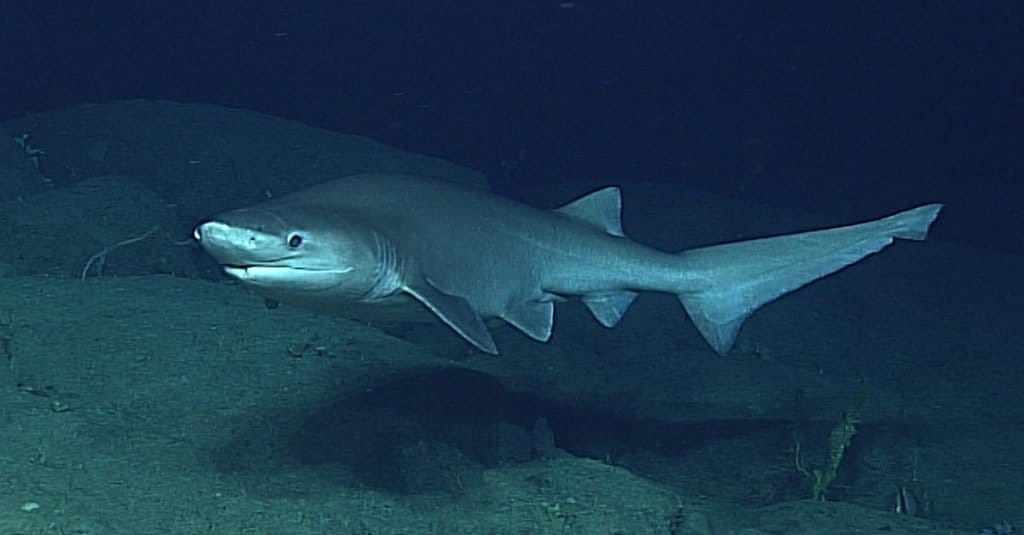
Bluntnose sixgill sharks closely resemble extinct sharks
©NOAA Ocean Explorer from USA / CC BY-SA 2.0 – Original / License
Also known as cow sharks, bluntnose sixgill sharks are primitive sharks that closely resemble more extinct sharks than living ones. Their snout is wide and blunt and they are tan, brown, or black and can reach 20 feet long. Bluntnose sixgill sharks are particularly unusual as they have six pairs of gill slits instead of the more common five. Bluntnose sixgill sharks live in the Atlantic, Indian, and Pacific oceans near the ocean floor. They are deep sea sharks and live in depths between 590 and 3,600 feet, but their range can sometimes extend to around 8,000 feet. Bluntnose sixgill sharks have a widely varied diet and undergo diurnal vertical migration. This is where they swim closer to the surface of the ocean during the night (usually around 984ft) to feed and then swim back down to their maximum depth at the ocean floor for the day.
9. Goblin Shark
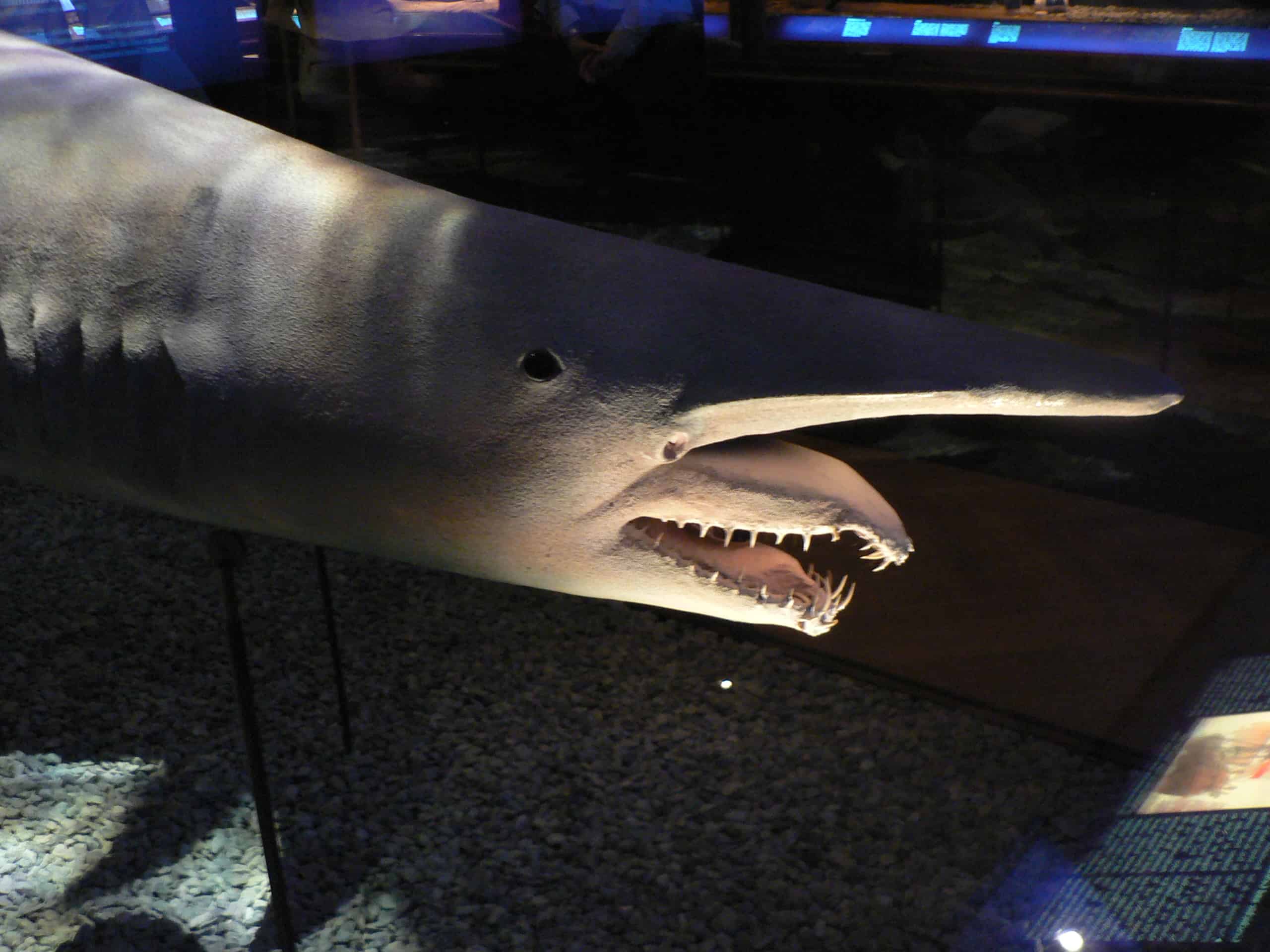
Living fossils – goblin sharks are the only living member of a family group that dates back millions of years
Goblin sharks are often called “living fossils” as they are the only living members of the family group Mitsukurinidae which dates back many million years. They have a very long, flat snout and protruding jaws which can extend to the end of their snout when feeding. Their unusual appearance is what earned them their name due to their resemblance to a goblin. Goblin sharks are usually between 10 and 13 feet long and live in all major oceans. They live over the upper continental slope between 900 and 3,150 feet, although they can go as deep as 4,300 feet. A tooth from a goblin shark was even found in an undersea cable which had been at 4,490 feet. Goblin sharks are slow swimmers and are ambush predators, feeding on squid and fish such as rattails.
8. Greenland Shark
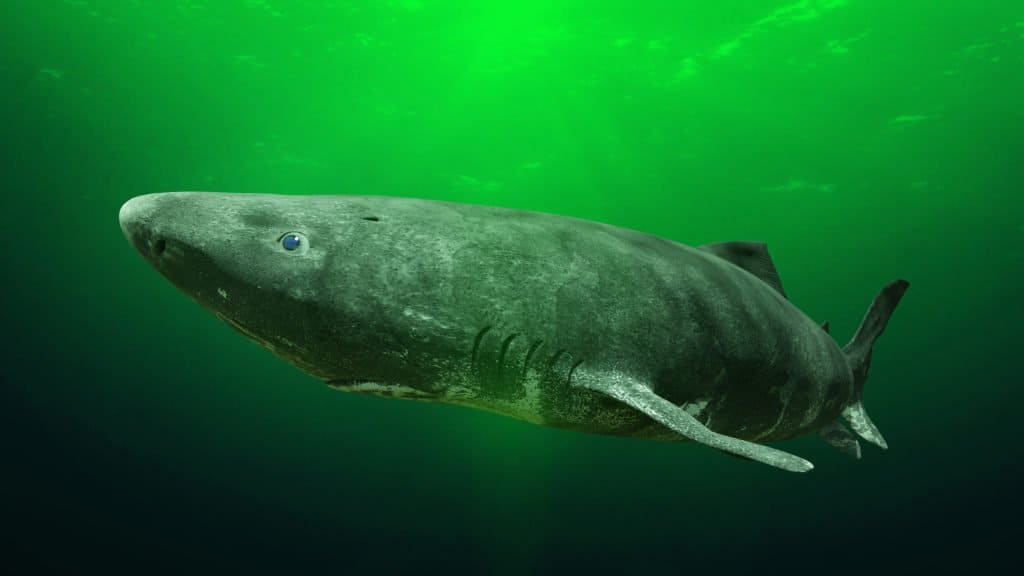
Greenland sharks have the longest lifespan of all sharks
©iStock.com/dottedhippo
Some of the most incredible sharks around are Greenland sharks – not only can they survive at unimaginable depths, but they have the longest lifespan of all sharks – estimated to be between 250 and 500 years. They are large sharks and regularly reach around 21 feet long. Their snouts are short and round and they have relatively small dorsal and pectoral fins for their size. Greenland sharks live in the Arctic and sub-Arctic waters of the North Atlantic and Arctic oceans and generally live in some of the deepest areas of the ocean. Greenland sharks were spotted at 7,200 feet by a submersible that was investigating the wreck of the SS Central America. Most Greenland sharks migrate every year, but their migration is based on depth. They migrate to the shallows during the winter and then back down to great depths for the summer.
7. Frilled Shark
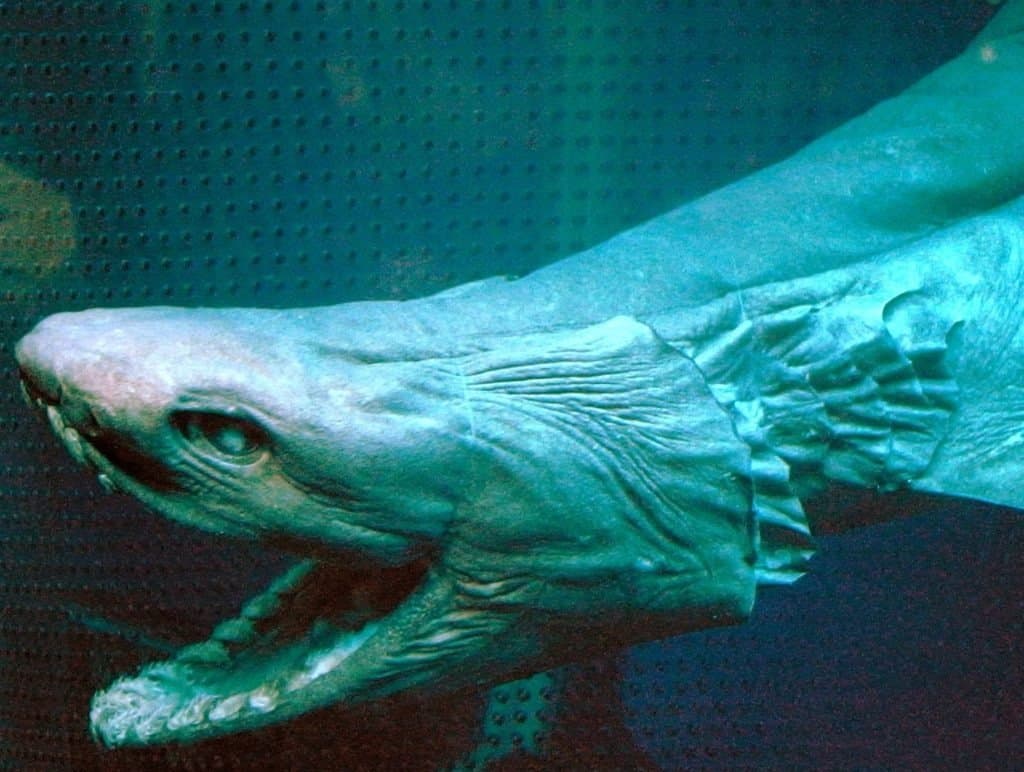
Frilled sharks get their name from their frilled gills
Another unusual deep sea shark that is considered a living fossil is the frilled shark. Frilled sharks get their name from their gill slits which have a fringed appearance. Frilled sharks have eel-like bodies, are dark brown, and reach 6.6 feet long. They eat a range of smaller sharks, bony fish, squid, and octopus and hunt by lunging at their prey and swallowing it whole. Frilled sharks live over the upper continental slope in the Atlantic and Pacific oceans in water up to 3,900 feet deep. However, they are often caught as bycatch and have been captured in water as deep as 5,150 feet.
6. Cookiecutter Shark
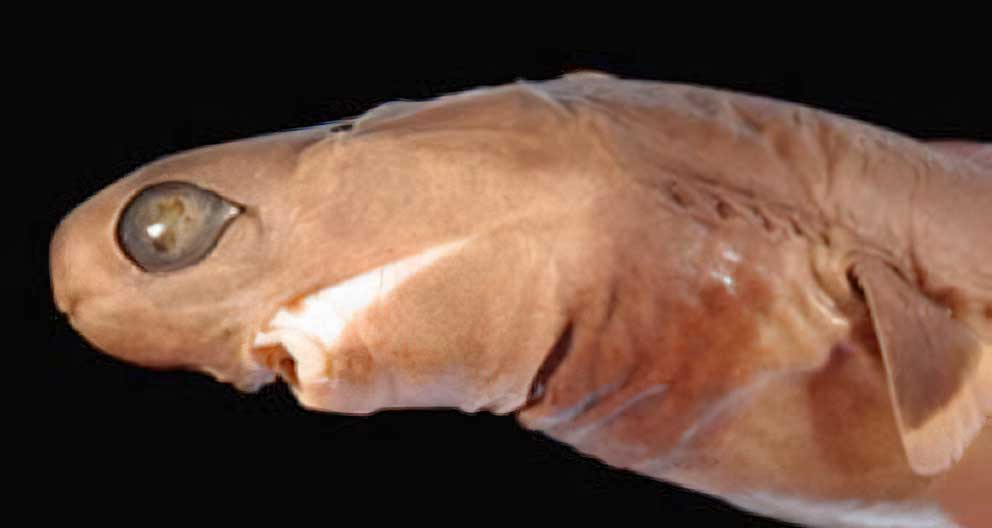
Size can be deceiving – cookiecutter sharks prey on animals much bigger than themselves
©Karsten Harte / public domain / Wikimedia Commons – Original / License
Cookiecutter sharks are some of the smallest sharks around and only measure between 16 and 22 inches long. They are dark brown but have photophores on their undersides which are organs that appear as luminous spots. Cookiecutters live in warm water worldwide at depths up to 12,100 feet. They spend their days at 3,200 feet and below and then rise to shallower depths during the night, although generally remaining below 280 feet. Cookiecutter sharks create deep, round holes in their prey when they bite them. This allows them to prey on animals much bigger than themselves. Many marine mammals have scars and wounds from cookiecutters. There have even been many times that they have damaged submarines by biting them, damaging the sides and sonar cable.
5. Swell Shark
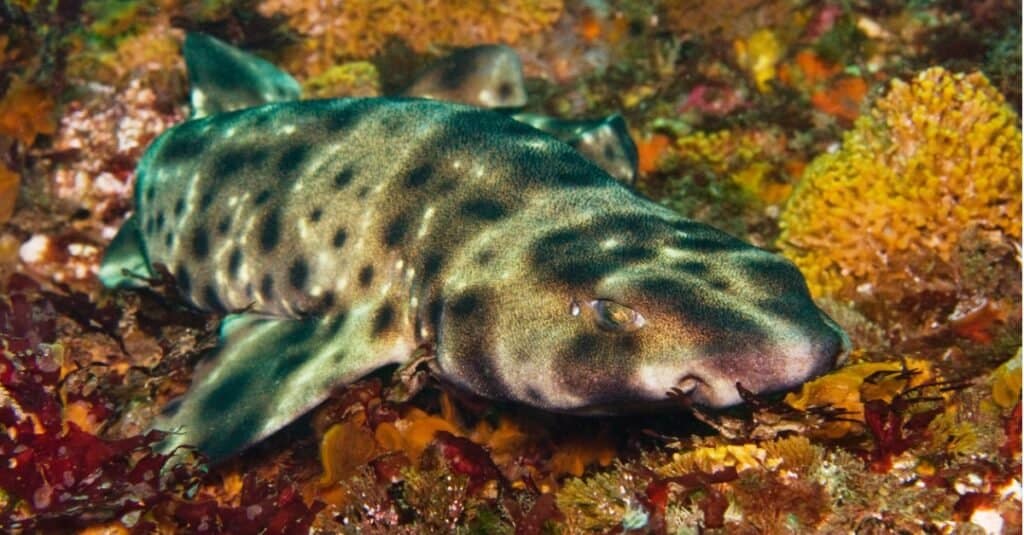
Swell sharks can double in size by swallowing water
©iStock.com/Natalie Ruffing
Some of the most unique sharks are swell sharks. Swell sharks are a species of catshark that lives in the Pacific Ocean, between California and southern Mexico. Swell sharks can be found as deep as 1,500 feet and inhabit rocky bottoms where they can hide in rock crevices all day. They are not particularly large and only reach a maximum of 43 inches, but they have a fascinating defense mechanism. Swell sharks grab their tails in their mouths when they feel threatened and suck in water. When they suck in water their stomachs expand, making them around twice their usual size and much harder for a predator to attack.
4. Kitefin Shark

Kitefin sharks, like cookiecutter sharks, have the ability to take huge chunks out of much larger animals, including whales.
©CSIRO National Fish Collection, CC BY 3.0 – Original / License
Another luminous shark is the kitefin shark. Kitefin sharks live in several populations around the world in tropical and subtropical waters close to the sea floor. They are mostly found between 660 and 2,000 feet, but some have been caught as deep as 5,900 feet. Kitefin sharks have very short, round snouts and their average length is around 4 feet. Kitefin sharks, like cookiecutter sharks, have the ability to take huge chunks out of much larger animals, including whales. They prey on a wide variety of animals, including smaller sharks, skates, and bony fish.
3. Ninja Lanternshark

When they are feeding in shallower waters, the ninja lanternshark’s luminous belly has the same appearance as the sunlight filtering down from above and camouflages them from would-be predators.
©Victoria Elena Vasquez/Journal of the Ocean Science Foundation, CC BY 4.0 – Original / License
A new species of deep sea shark that was only discovered in 2010 is the ninja lanternshark. Ninja lanternsharks occur along the continental slope in the eastern Pacific Ocean and their depth ranges from 2,740 to 4,735 feet. They are extremely small sharks and reach no more than 20 inches long. Ninja lanternsharks are black and have white markings around their mouths. They are also luminous which acts as both camouflage and attracts prey. When they are feeding in shallower waters their luminous belly has the same appearance as the sunlight filtering down from above and camouflages them from would-be predators below. However, when they are in the deepest depths of the ocean, their luminous appearance attracts smaller prey to them.
2. Portuguese Dogfish

Portuguese dogfish are sleeper sharks and are typically around 3 feet long.
Portuguese dogfish are the deepest of all deep sea sharks and have been found at an incredible 12,057 feet. They have a wide range around the world, but most often occur near the bottom of the deepest oceans. Portuguese dogfish are sleeper sharks and are typically around 3 feet long. They are dark brown and have round, flattened snouts and small spines in front of their dorsal fin. Portuguese dogfish eat mainly cephalopods and bony fish and occasionally prey on other sharks.
1. Megamouth Shark

One of three filter-feeding sharks is the megamouth shark
Megamouth sharks live so deep that they are rarely seen by humans and less than one hundred have been seen since the species was first discovered in 1976. Like basking and whale sharks, megamouth sharks are filter feeders and mainly eat plankton. As their name suggests, megamouth sharks have massively wide mouths which are filled with tiny teeth. Megamouths are brownish-black above and white below, and can feet 18 feet long. They are fairly widespread around the world and live up to 3,280 feet deep. Like many other deep sea animals, they spend their days at the deepest depths and rise closer to the surface during the night to feed.
Honorable Mentions: Other Deep Sea Sharks
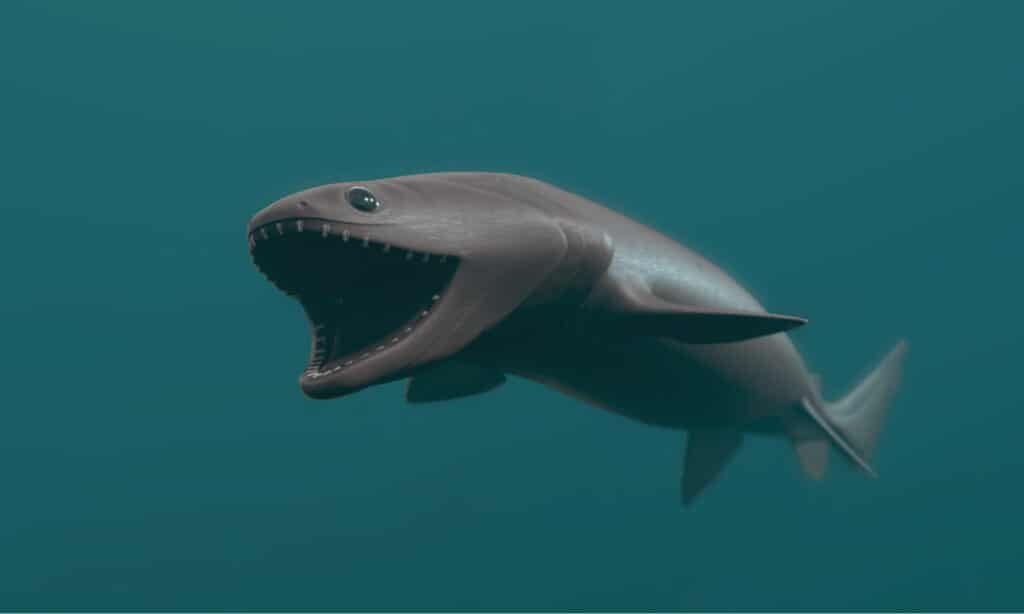
The shortnose demon catshark is only found in the East China Sea.
©iStock.com/3dsam79
There are over 500 species of sharks that reside in the deep sea. While this may be too extensive of a listing, we can highlight some of the other interesting well-known sharks, from the shortnose demon catshark, and the viper dogfish, to the frilled shark, also known as the lizard shark.
- Shortnose Demon Catshark (Apristurus internatus) – this deep sea dweller belongs to the family Scyliorhinidae, a species of ground shark, and is only found in the East China Sea. These mostly nocturnal bottom feeders can reach up to almost 16 feet in length.
- Viper Dogfish (Trigonognathus kabeyai) – this is a rare species of shark belonging to the family Etmopteridae. It is the only member of its genus and can be found in the Pacific Ocean in the following areas: the Bonin Islands, southern Japan, off northern Taitung County, and the Northwestern Hawaiian Islands. This shark is skinny and can reach lengths of up to 21 inches.
- Gulper Shark (Centrophorus granulosus) – belonging to the dogfish family, this long-snouted shark can be found in deep, murky waters all over the world, in depths of 300 to 800 meters, and can reach up to three feet in length. Gulper sharks are currently listed as an endangered species.
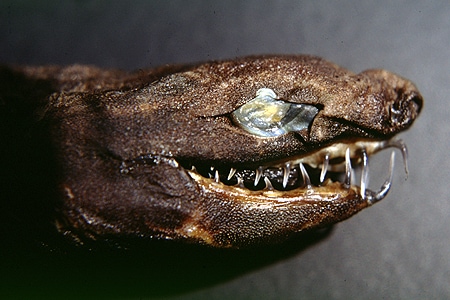
The viper dogfish is a rare species of shark that can be found in the Pacific Ocean.
Summary of 10 Deep Sea Sharks
| Number | Deep Sea Shark |
|---|---|
| 1 | Megamouth Shark |
| 2 | Portuguese Dogfish |
| 3 | Ninja Lanternshark |
| 4 | Kitefin Shark |
| 5 | Swell Shark |
| 6 | Cookiecutter Shark |
| 7 | Frilled Shark |
| 8 | Greenland Shark |
| 9 | Goblin Shark |
| 10 | Bluntnose Sixgill Shark |
The photo featured at the top of this post is © iStock.com/dottedhippo
Thank you for reading! Have some feedback for us? Contact the AZ Animals editorial team.







